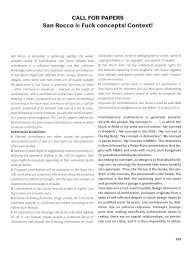CALL FOR PAPERS San Rocco 2: The Even Covering of the Field
CALL FOR PAPERS San Rocco 2: The Even Covering of the Field
CALL FOR PAPERS San Rocco 2: The Even Covering of the Field
Create successful ePaper yourself
Turn your PDF publications into a flip-book with our unique Google optimized e-Paper software.
and <strong>the</strong> “field”? Is modification, as Gregotti suggests,<br />
still a viable strategy within <strong>the</strong> field?<br />
• <strong>The</strong> <strong>Field</strong> is Already Here •<br />
Recent Japanese architecture seems to be <strong>the</strong> first<br />
to develop an aes<strong>the</strong>tic that entirely depends upon a<br />
“field” condition. <strong>The</strong> New Naives seem to take this for<br />
granted. <strong>The</strong> result <strong>of</strong> <strong>the</strong>ir attitude is a set <strong>of</strong> buildings<br />
whose ambitions do not expand beyond <strong>the</strong>ir borders.<br />
<strong>The</strong>se projects are incredibly ambitious – and almost<br />
cruel – inside, and desperately resigned outside, towards<br />
<strong>the</strong> environment in which <strong>the</strong>y are located.<br />
New Naives suggest to design <strong>the</strong> city starting from a<br />
new, sublime weakness. It is possible to find a somewhat<br />
similar attitude in recent British architecture, yet<br />
in England <strong>the</strong> “field” seems to be less naive. In recent<br />
British architecture (like that <strong>of</strong> Caruso St John, Fretton<br />
or Sergison Bates), a picturesque attitude provides<br />
a possible reading <strong>of</strong> <strong>the</strong> micro-geographies hidden<br />
within <strong>the</strong> field. Feeble traces <strong>of</strong> beauty are recognized<br />
in <strong>the</strong> grey fragments scattered around. Contemporary<br />
British architects try to convince us with <strong>the</strong>ir eulogy <strong>of</strong><br />
<strong>the</strong> banal: <strong>the</strong> brick, <strong>the</strong> pebble, <strong>the</strong> ivy on <strong>the</strong> wall, <strong>the</strong><br />
asphalt <strong>of</strong> <strong>the</strong> car park, a concrete pillar with smoo<strong>the</strong>d<br />
corners, an ugly lamp. More than a dubious phenomenology<br />
(touching <strong>the</strong> brick, eating <strong>the</strong> moss, licking <strong>the</strong><br />
pillars), this type <strong>of</strong> attention seems to contain a residual<br />
urban potential: <strong>the</strong> mediocrity <strong>of</strong> our cities finally<br />
confronted in all seriousness; “context” in its unbearable<br />
extension; context as a field – “Reality as found” next<br />
to “Reality as found” next to “Reality as found”.<br />
• Black Hole House •<br />
While mourning <strong>the</strong> death <strong>of</strong> her daughter, a woman<br />
loses her young husband, <strong>the</strong> firearm magnate William<br />
Wirt Winchester. Saddened by <strong>the</strong>se tragic events, <strong>the</strong><br />
widow is drawn to consult a medium, who leads her to<br />
believe that <strong>the</strong>re is a curse upon her family: thousands<br />
<strong>of</strong> people have died because <strong>of</strong> <strong>the</strong> guns <strong>the</strong> Winchesters<br />
have manufactured, and <strong>the</strong> spirits <strong>of</strong> <strong>the</strong> dead are<br />
seeking revenge. She thus has to leave New Haven, go<br />
west and build a house for herself and <strong>the</strong> vengeful spir-<br />
176<br />
its. Sarah moves to <strong>San</strong> José, California, where she buys<br />
an old country mansion. Under her day-to-day direction,<br />
from 1884 until her death in 1922, a team <strong>of</strong> craftsmen<br />
expands <strong>the</strong> house without any precise long-term<br />
plan. <strong>The</strong> building grows into a seemingly inexhaustible<br />
balloon-frame Maelstrom, continuously consuming materials<br />
and time: 160 rooms, 47 fireplaces, 10,000 windowpanes.<br />
Sarah Winchester elevates <strong>the</strong> everyday paranoia<br />
<strong>of</strong> contemporary suburbs to <strong>the</strong> level <strong>of</strong> madness.<br />
To build is to defend. To build is to protect. To build is<br />
to escape from <strong>the</strong> city. <strong>The</strong> villa is actually a stronghold.<br />
Yet in Winchester House, <strong>the</strong> labyrinthine field<br />
that is usually produced on <strong>the</strong> outside <strong>of</strong> paranoiac villas<br />
invades <strong>the</strong> interior as well. <strong>The</strong> confusion <strong>of</strong> <strong>the</strong> city<br />
outside takes its revenge on <strong>the</strong> heavily protected interior.<br />
In 1906, an earthquake levels <strong>the</strong> top three floors<br />
<strong>of</strong> <strong>the</strong> house, leaving only four floors standing. Sarah is<br />
trapped inside <strong>the</strong> building. Given that she sleeps in<br />
a different room each night, <strong>the</strong> servants do not know<br />
where to search for her. <strong>The</strong>y take almost twenty-four<br />
hours to find her.<br />
• Planning, What Else? •<br />
It would seem that contemporary environmental issues<br />
can only be solved by starting from <strong>the</strong> point <strong>of</strong> view <strong>of</strong><br />
totality (“Aus dem Gesichtspunkt der Totalität”, to use a<br />
marvellously outdated expression by Lukács). Is it time<br />
for <strong>the</strong> great revenge <strong>of</strong> planning?




